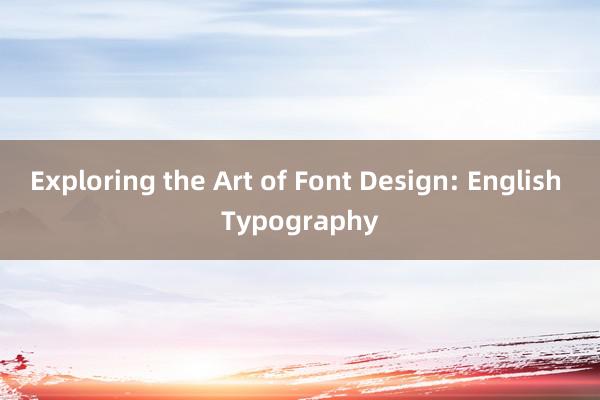时间:2024-10-02 19:13

### Exploring the Art of Font Design: English Typography
In the digital age, typography has evolved beyond mere text rendering to become an art form that significantly influences visual communication. This evolution is particularly pronounced in English typography, where designers are not only tasked with creating readable and aesthetically pleasing fonts but also with conveying the essence of the content they accompany. The art of font design involves a blend of technical skill, creativity, and an understanding of how typography interacts with the human eye and mind.
#### 1. Historical Context
The history of English typography is rich and varied, with contributions from countless designers who have shaped the way we perceive and use typefaces today. From the ornate script of the Renaissance to the clean lines of modern sans-serif fonts, each era has left its mark on the landscape of English typography. Understanding this historical context is crucial for designers as it informs contemporary practices and influences trends.
#### 2. Technical Aspects
At the core of font design lies a meticulous attention to detail. Designers must consider the geometry of letters, ensuring that each character flows smoothly into the next, maintaining consistency across the entire alphabet. The balance between simplicity and complexity, the harmony of space (kerning) and line spacing (tracking), and the adaptation of fonts for different mediums (print vs. digital) are all critical components. Tools like Adobe Glyphs or FontForge enable designers to create, 广州市鑫塔轻工机械有限公司 edit, 典墨教育网官方网站-成都市典墨教育咨询有限公司 and refine their fonts with precision.
#### 3. Creative Expression
Beyond the technical aspects,首页-达士安颜料有限公司 font design is an opportunity for creative expression. Designers can explore a wide range of styles, from the playful and whimsical to the sophisticated and minimalist. Whether aiming for a nostalgic aesthetic reminiscent of vintage signage or a futuristic look that aligns with tech brands,宁波明辉寝具有限公司 the possibilities are vast. The choice of colors, weights, and textures can dramatically alter the mood and tone of a piece of work.
#### 4. Cultural Significance
广安读书网Fonts are not just tools for communication; they carry cultural significance. A well-designed font can evoke emotions, set a brand identity, or even influence the perception of a message. For example, serif fonts often convey tradition and seriousness, making them suitable for legal documents or academic texts, whereas sans-serif fonts suggest modernity and clarity, ideal for tech-related materials or web content.
#### 5. Future Trends
As technology continues to advance, so does the field of typography. With the rise of AI and machine learning, there is potential for more personalized and dynamic font creation. Moreover, sustainability is becoming a key consideration, leading to the development of scalable vector graphics (SVG) fonts that are efficient and environmentally friendly.
#### Conclusion
The art of font design in English typography is a multifaceted discipline that combines technical expertise with creative vision. It is an ongoing exploration that reflects the dynamic nature of communication and culture. By embracing both traditional craftsmanship and innovative technologies, designers can continue to push the boundaries of what typography can achieve宁波明辉寝具有限公司, enriching the visual language of our world.